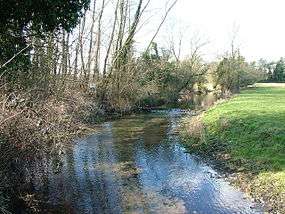River Mimram
The River Mimram is a river in Hertfordshire, England.
| Mimram | |
|---|---|
 The river near Tewin | |
| Location | |
| Country | United Kingdom |
| Physical characteristics | |
| Source | |
| • location | Nr. Whitwell |
| • elevation | 90 m (300 ft) |
| Mouth | |
• location | Hertford, Hertfordshire into River Lea |
• coordinates | 51°47′35.4″N 0°5′16.5″W |
| Length | 20 km (12 mi) |
Geography
The river valley known locally as the Mimram Valley is named after the River Mimram, which rises from a spring to the north-west of Whitwell, in North Hertfordshire, England, and makes its confluence with the River Lea near Horn's Mill in Hertford. At Whitwell there are watercress beds which have existed since Roman times and these are fed by the same springs. The valley extends northwards where it becomes known as Lilley Bottom. Other sections of the valley are known as Kimpton Bottom and Codicote Bottom. After flowing through Whitwell, Kimpton and Codicote, the river flows through the middle of Welwyn village before heading between the modern and older Digswell settlements, and then running cross-country until it reaches the River Lea at Hertford.
Although a dry valley to the north, it has been known in particularly wet years for the River Mimram to be extended for several miles by springs in the upper valley. In 2001, in a neighbouring valley to the west a village was flooded.[1] The Valley is the furthest east of all the Chiltern Hills valleys.
Literary references
The river is the subject (and speaker) of a Stevie Smith poem, The River God. Popular and enjoyable though this poem has been for its many readers, the description of the river in the poem bears little relation to the geography of the actual Mimram.
Etymology
The name "Mimram" is typically believed to be of Celtic origin. Rutherford Davis states "etymology unknown, but there is little reason to doubt it is Celtic".[2] Etymological connections have been suggested by academic philologists with the River Mint in Westmorland and with North Mymms in south Hertfordshire. There have been suggestions of it being named after a Celtic deity, though no academic sources have been cited for this and the speculation likely stems from a comparison with etymology for the nearby River Beane. Generally, etymologists and philologists have found the name 'Mimram' hard to analyse as there has been so little raw material on which to work until well into the Saxon era, by which time multiple forms of the name appear in records.
Eilert Ekwall believes the Old English version of the name was Memere or Mere (Mære), and that, given the dubious nature of early forms, no etymology can realistically be attempted.[3]
Historically, the river has also been known by the name "Maran" and many maps from the nineteenth and early twentieth centuries mark the river's name as "Mimram or Maran". Indeed, up until the 1960s and 1970s, most local residents referred the area around it as the Maran Valley rather than the Mimram Valley.[4] Downstream in Digswell there is a homestead property dating from the sixteenth century that has the name "Maran House". It has been speculated[5] that "Maran" may hark back to the homelands of the Catuvellauni tribe, the Celts who came to Hertfordshire from a region of modern-day Belgium and Northern France where the main river is the Marne, after which a whole department of France is named. The prefecture of Marne is Châlons-en-Champagne, formerly called Châlons-sur-Marne - with the name "Châlons" being etymologically derived from the name of the local Belgic tribe of the Catalauni. However, the link between the French Catalauni and the British Catuvellauni is not categorically proven: some texts assume they are connected (including, recently, Graham Robb's "The Ancient Paths"), while others infer a lack of connection from the lack of proof.
Crossings
The Mimram is crossed at Digswell by Welwyn Viaduct, carrying the East Coast main line as well as commuter services to Peterborough and Cambridge.
References
- Kimpton Flood
- Rutherford Davis, Kenneth (1982). Britons and Saxons: The Chiltern Region 400-700. Phillimore. p. 154.
- Eilert Ekwall (1928). English River Names. OUP. p. 290.
- What’s in a name?
- Quiet Flows the…?
External links
| Wikimedia Commons has media related to River Mimram. |
Further reading
- Rook, Tony (2014). River Mimram. Amberley Publishing. ISBN 9781445633282.